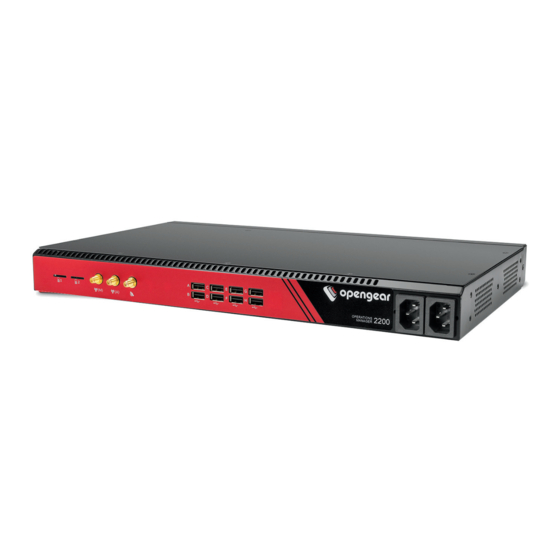
Advertisement
Quick Links
Advertisement

Summary of Contents for Opengear Operations Manager 2200
-
Page 2: What's In The Box
1. REGISTER This Quick Start Guide covers basic installation and configuration of your new OM2200. For in-depth guidance, consult the OM2200 User Manual. Register your product: https://opengear.com/product-registration When you register, you: • Activate your warranty • Get notified when firmware updates are released For licensing information and access to source code, visit: https://opengear.com/software-licenses... - Page 3 For the complete list of what’s inside the box, visit: https://opengear.com/products/om2200-operations-manager/#inside...
- Page 4 After opening the box: DO NOT POWER ON RIGHT AWAY 3. ASSEMBLE NOTE: OM22xx models have two SFP/Ethernet Gigabit labeled NET1 and NET2. OM22xx-10G models have SFP+ 10 gigabit connection labeled NET1 and SFP/Ethernet labeled NET2. Connect to a computer or into your network from any NET port for initial configuration.
- Page 5 4. LOG IN Browse to 192.168.0.1 (subnet mask 255.255.255.0) with a computer on the same LAN as the console server.* NOTE: The device has a self-signed SSL certificate. Untrusted connection errors appear. Click through the errors to the login page. Log in with username root and password default.
-
Page 6: Change Root Password
5. CHANGE ROOT PASSWORD Click CONFIGURE > User Management > Local Users. Click the Edit button next to the root user. On the User Details page, enter and confirm the new password. Scroll to the bottom of the page and click Save User. -
Page 7: Change Ip Settings
6. CHANGE IP SETTINGS DHCP is enabled by default. To change to a static IP click CONFIGURE > Network Connections > Network Interfaces. Click the Edit button next to IPv4 DHCP, to modify the DHCP setting. Change Connection Type and fill in the requested information in the form that appears. -
Page 8: Configure Serial Ports
7. CONFIGURE SERIAL PORTS To change settings for individual serial ports, click CONFIGURE > Serial Ports. Click Edit next to the port you wish to modify. You can change common settings, logging settings, and set IP aliases per serial port. Click Apply. - Page 9 8. ADD USERS AND GROUPS To add a new user, click CONFIGURE >User Management > Local Users. Scroll to the bottom of the page and click Add User. Enter a Username and enter and confirm a Password. Select the appropriate groups. Check the User Enabled box. Click Save User to create the new user account.
- Page 10 NOTE: You should create a new administrative user rather than continuing as the root user. To do so, add a new user to the admin group with full access privileges. Log out and log back in as this new user for all administrative functions.
- Page 11 9. ACCESS DEVICE CONSOLES Your console server is now ready to access device consoles on your network. SSH: • Connect to the pmshell chooser menu, SSH to the console server and log in appending :serial to your username, e.g. root:serial. •...
- Page 12 – Network Computing Magazine Product Review – Dec 2017 Ready to learn more? Visit lighthouse.opengear.com to download a free evaluation of Lighthouse 5 (up to 5 nodes) and to learn more about Opengear’s Centralized Management solutions.


Need help?
Do you have a question about the Operations Manager 2200 and is the answer not in the manual?
Questions and answers